How To Install Python 3.4 On Windows
Introduction
Python is a widely used high-level programming linguistic communication first launched in 1991. Since then, Python has been gaining popularity and is considered as one of the most popular and flexible server-side programming languages.
Unlike most Linux distributions, Windows does not come up with the Python programming language by default. All the same, you lot can install Python on your Windows server or local machine in just a few easy steps.

Prerequisites
- A organisation running Windows 10 with admin privileges
- Control Prompt (comes with Windows past default)
- A Remote Desktop Connection app (use if you lot are installing Python on a remote Windows server)
Python 3 Installation on Windows
Step 1: Select Version of Python to Install
The installation procedure involves downloading the official Python .exe installer and running information technology on your system.
The version yous need depends on what you lot want to do in Python. For case, if you are working on a project coded in Python version ii.6, you lot probably need that version. If you are starting a project from scratch, you have the liberty to cull.
If you are learning to code in Python, we recommend you download both the latest version of Python 2 and 3. Working with Python 2 enables you to work on older projects or test new projects for astern compatibility.
Annotation: If yous are installing Python on a remote Windows server, log in via Remote Desktop Protocol (RDP). Once you log in, the installation procedure is the same equally for a local Windows machine.
Step ii: Download Python Executable Installer
- Open your web browser and navigate to the Downloads for Windows section of the official Python website.
- Search for your desired version of Python. At the fourth dimension of publishing this article, the latest Python 3 release is version iii.vii.3, while the latest Python 2 release is version two.7.16.
- Select a link to download either the Windows x86-64 executable installer or Windows x86 executable installer. The download is approximately 25MB.
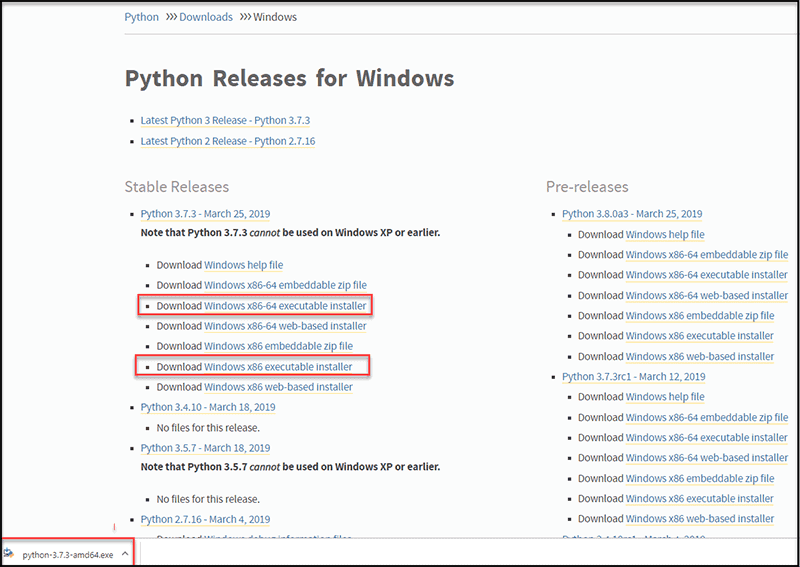
Notation: If your Windows installation is a 32-bit system, yous need the Windows x86 executable installer. If your Windows is a 64-scrap version, you need to download the Windows x86-64 executable installer. There is nothing to worry about if you install the "incorrect" version. Yous tin uninstall one version of Python and install another.
Stride 3: Run Executable Installer
1. Run the Python Installer once downloaded. (In this example, we have downloaded Python 3.vii.three.)
2. Make certain you select the Install launcher for all users and Add Python 3.7 to PATH checkboxes. The latter places the interpreter in the execution path. For older versions of Python that do not support the Add Python to Path checkbox, see Step six.
3. Select Install At present – the recommended installation options.

For all recent versions of Python, the recommended installation options include Pip and IDLE. Older versions might not include such additional features.
4. The next dialog will prompt yous to select whether to Disable path length limit. Choosing this option will allow Python to bypass the 260-grapheme MAX_PATH limit. Effectively, information technology volition enable Python to use long path names.
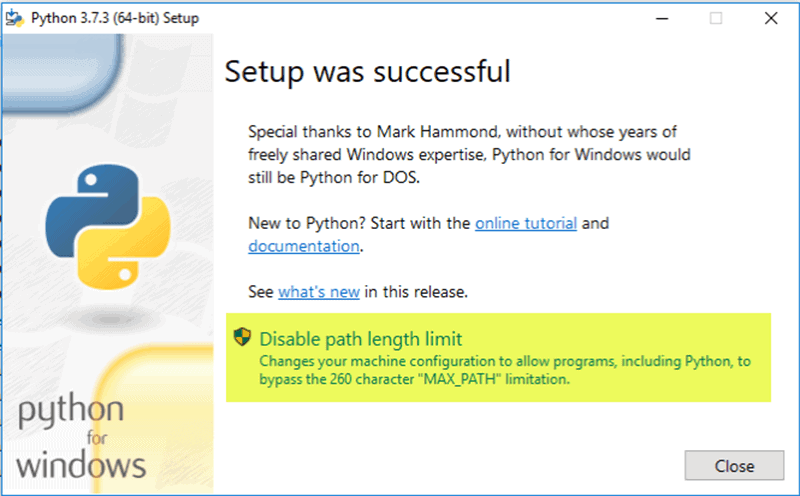
The Disable path length limit selection will not affect whatsoever other organization settings. Turning it on will resolve potential name length issues that may arise with Python projects developed in Linux.
Footstep 4: Verify Python Was Installed On Windows
- Navigate to the directory in which Python was installed on the system. In our case, it is C:\Users\Username\AppData\Local\Programs\Python\Python37 since nosotros have installed the latest version.
- Double-click python.exe.
- The output should be like to what you can come across below:
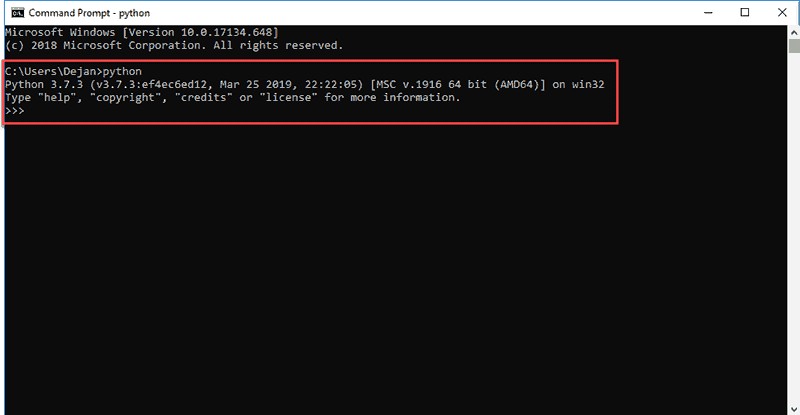
Note: You tin can also check whether the installation was successful by typing python –V in Command Prompt. The output should display your installed version of Python. In our case, it is "Python 3.vii.3."
Step 5: Verify Pip Was Installed
If you opted to install an older version of Python, it is possible that it did not come with Pip preinstalled. Pip is a powerful package direction organisation for Python software packages. Thus, make sure that you have it installed.
Nosotros recommend using Pip for near Python packages, especially when working in virtual environments.
To verify whether Pip was installed:
- Open up the Start bill of fare and type "cmd."
- Select the Control Prompt awarding.
- Enter
pip -Vin the console. If Pip was installed successfully, you should see the following output:
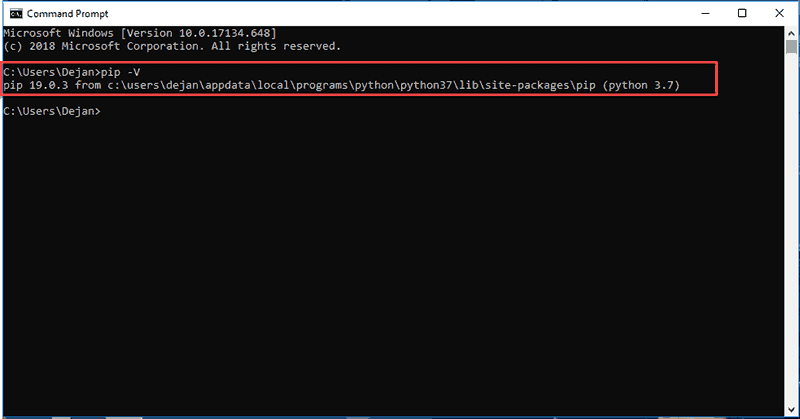
Pip has not been installed yet if you go the post-obit output:
'pip' is not recognized every bit an internal or external control, Operable programme or batch file. If your version of Python is missing Pip, see our article How to Install Pip to Manage Python Packages on Windows.
Step vi: Add together Python Path to Environs Variables (Optional)
We recommend y'all go through this stride if your version of the Python installer does not include the Add Python to PATH checkbox or if yous have not selected that pick.
Setting up the Python path to system variables alleviates the need for using full paths. Information technology instructs Windows to look through all the PATH folders for "python" and notice the install binder that contains the python.exe file.
1. Open up the Start card and first the Run app.
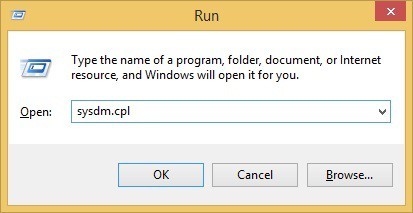
2. Type sysdm.cpl and click OK. This opens the System Backdrop window.
3. Navigate to the Avant-garde tab and select Environment Variables.
4. Under Organisation Variables, observe and select the Path variable.
5. Click Edit.
6. Select the Variable value field. Add together the path to the python.exe file preceded with a semicolon (;). For example, in the prototype below, we have added ";C:\Python34."
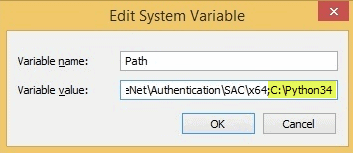
7. Click OK and shut all windows.
By setting this up, you can execute Python scripts like this: Python script.py
Instead of this: C:/Python34/Python script.py
Equally you can run across, it is cleaner and more manageable.
Pace vii: Install virtualnv (Optional)
You lot accept Python, and you take Pip to manage packages. At present, you lot demand one final software package - virtualnv. Virtualnv enables yous to create isolated local virtual environments for your Python projects.
Why use virtualnv?
Python software packages are installed system-wide by default. Consequently, whenever a unmarried projection-specific package is changed, it changes for all your Python projects. You would want to avert this, and having divide virtual environments for each projection is the easiest solution.
To install virtualnv:
1. Open the Start menu and type "cmd."
ii. Select the Command Prompt application.
three. Type the following pip command in the panel:
C:\Users\Username> pip install virtualenv Upon completion, virtualnv is installed on your system.
Conclusion
In this tutorial, we detailed how to install Python 3.7.3 on Windows. If you are installing a different version of Python, you tin wait a similar process.
To upgrade Python to a newer version, cheque our article how to upgrade Python to iii.9.
Remember, choose your version carefully, make certain that you accept Pip installed, and apply virtual environments when developing multiple projects on a single system.
Want to try out another new generation, server-side scripting languages? Bank check out How to Install Blood-red on Windows x.
Happy coding!
Was this commodity helpful?
Aye No
Source: https://phoenixnap.com/kb/how-to-install-python-3-windows
Posted by: mcdanielbescarrelus.blogspot.com

0 Response to "How To Install Python 3.4 On Windows"
Post a Comment